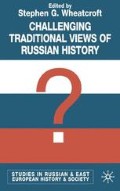Abstract
Most economic historians characterise the period between 1860 and the First World War as a period of economic globalisation and convergence in which the culture of modern industrialism evolved, spread throughout the manufacturing world and came to have a fateful impact upon the dynamics of social, political and economic relations within every polity it touched.1
Access this chapter
Tax calculation will be finalised at checkout
Purchases are for personal use only
Preview
Unable to display preview. Download preview PDF.
Notes
Jeffrey G. Williamson, ‘Globalization, Convergence, and History’, The Journal of Economic History, 56 (June 1996) 277.
For the Russian image of Americanism, see Hans Rogger, ‘Americanizm and the Economic Development of Russia’, Comparative Studies in Society and History, 23 (July 1981) 382–420;
Kendall Bailes, ‘The American Connection: Ideology and the Transfer of American Technology to the Soviet Union, 1917–1941’, Comparative Studies in History and Society, 23 (3 July 1981) 421–48.
For the impact of Taylor and Ford, see David A. Hounsell, From the American System to Mass Production, 1800–1932: the Development of Manufacturing Technology in the United States (Baltimore: Johns Hopkins University Press, 1984);
Karel Williams, Colin Hasiam and John Williams, ‘Ford-v-Fordism: the Beginnings of Mass Production?’, Work, Employment and Society, 4 (December 1992) 517–52;
David Montgomery, The Fall of the House of Labor: the Workplace, the State and American Labor Activism, 1865–1925 (Cambridge: Cambridge University Press, 1987); and
Mary Nolan, Visions of Modernity: American Business and the Modernization of Germany (Oxford: Oxford University Press, 1994).
Kendall Bailes, Technology and Society under Lenin and Stalin: Origins of the Soviet Technical Intelligentsia, 1917–1941 (Princeton: Princeton University Press, 1978);
Heather Hogan, ‘Scientific Management and the St. Petersburg Metalworking Industry, 1900–1914’, in Leopold H. Haimson and Charles Tilly, eds, Strikes, Wars, and Revolutions in an International Perspective: Strike Waves in the Late Nineteenth and Early Twentieth Centuries (Cambridge: Cambridge University Press, 1989), pp. 356–79;
Heather Hogan, ‘The Origins of Scientific Management in Russia’, in Melvyn Dubovsky, ed., Technological Change and Workers’ Movements (Beverly Hills: Sage Publishing, 1985), pp. 77–94;
Heather Hogan, Forging Revolution: Metalworkers, Managers and the State in St. Petersburg, 1890–1914 (Bloomington: Indiana University Press, 1993);
Nicholas Lampert, The Technical Intelligentsia and the Soviet State (New York: Holmes & Meier, 1979);
Peter Gatrell, Government, Industry and Rearmament in Russia, 1900–1914: the Last Argument of Tsarism (Cambridge: Cambridge University Press, 1994).
Harley D. Balzer, ‘Educating Engineers: Economic Politics and Technical Training in Tsarist Russia’ (PhD diss., University of Pennsylvania, 1980);
Stephen Charles Ellis, ‘Management in the Industrialization of Russia, 1861–1917’ (PhD diss., Duke University, 1980);
Donald Webb Green, ‘Industrialization and the Engineering Ascendancy: a Comparative Study of Russian and American Engineering Elites, 1870–1920’ (PhD diss., University of California, Berkeley, 1972);
V. R. Leikina-Svirskaya, Intelligentsiya vRossii vo vtoroi polovine XIX veka (Moscow: Mysl’, 1971);
V. R. Leikina-Svirskaya, Russkaya intelligentsiya v 1900–1917 godakh (Moscow: Mysl’, 1981).
Fred V. Carstensen, American Enterprise in Foreign Markets: Studies of Singer and International Harvester in Russia (Chapel Hill: University of North Carolina Press, 1984);
V. S. Dyakin, Germanskie kapitaly v Rossii: elektroindustriya i elektricheskii transport (Leningrad: Nauka, 1971).
‘Finansovoe Agentstvo v S.Sh.A.’, ‘Sbornik Zapisok, Otnosiashchikhsia k Russkomu Snabzheniiu v Velikuiu voinu’, MS (hereafter ‘Sbornik’), Hoover Institution Archives (hereafter HIA), p. 162; Kendall Bailes, ‘The American Connection’, p. 423; Peter Gatrell, ‘Russian Heavy Industry and State Defence, 1908–1918: Pre-War Expansion and Wartime Mobilization’ (PhD diss., University of Cambridge, 1979), p. 149; Rogger, ‘ Americanizm’, 413.
Joseph Bradley, Guns for the Tsar: American Technology and the Small Arms Industry in Nineteenth-century Russia (DeKalb: Northern Illinois University Press, 1990), pp. 99–129.
R. J. Overy, War and Economy in the Third Reich (Oxford: Clarendon Press, 1994), p. 8.
Cecelia F. Bucki, ‘Dilution and Craft Tradition: Bridgeport, Connecticut, Munitions Workers, 1915–1919’, Social Science History, 4 (February 1980) 105–24; David Montgomery, ‘Strikes of Machinists in the United States, 1870–1922’, in Haimson and Tilly, Strikes, Wars and Revolutions, pp. 271–2, 277–8; Montgomery, The Fall of the House of Labor, pp. 169–70, 193, 282–6, 327–9.
For the teething problems experienced by Ford in 1913, see, for example, Carl H. A. Dassbach, ‘The Origins of Fordism: the Introduction of Mass Production and the Five-Dollar Wage’, Critical Sociology, 18 (spring 1991) 77–90.
Editor information
Editors and Affiliations
Copyright information
© 2002 Palgrave Macmillan, a division of Macmillan Publishers Limited
About this chapter
Cite this chapter
Zuckerman, F.R. (2002). The Russian Army and American Industry, 1915–17: Globalisation and the Transfer of Technology. In: Wheatcroft, S.G. (eds) Challenging Traditional Views of Russian History. Studies in Russian and East European History and Society. Palgrave Macmillan, London. https://doi.org/10.1057/9780230506114_3
Download citation
DOI: https://doi.org/10.1057/9780230506114_3
Publisher Name: Palgrave Macmillan, London
Print ISBN: 978-1-349-41342-3
Online ISBN: 978-0-230-50611-4
eBook Packages: Palgrave History CollectionHistory (R0)

